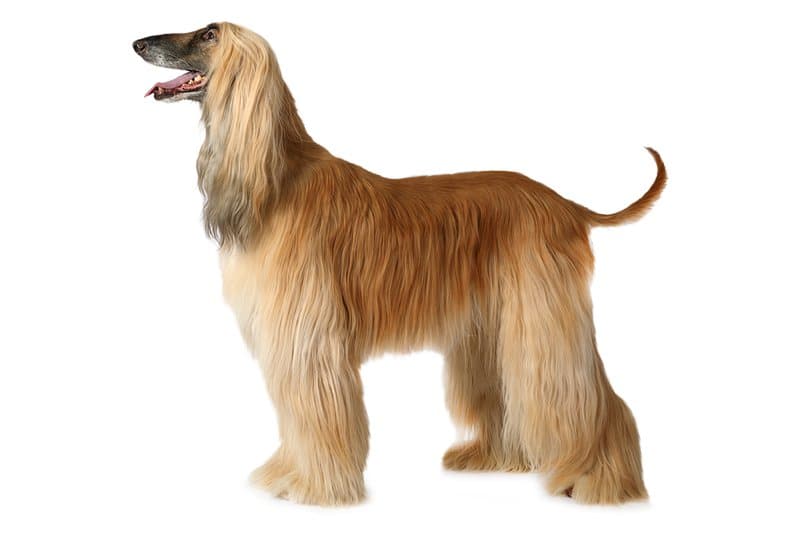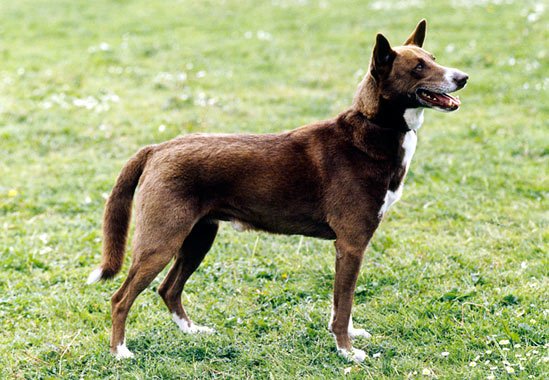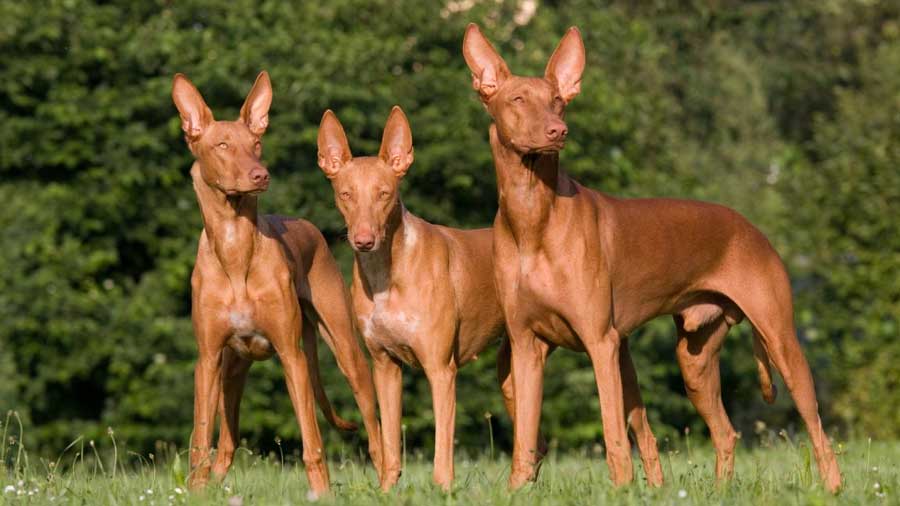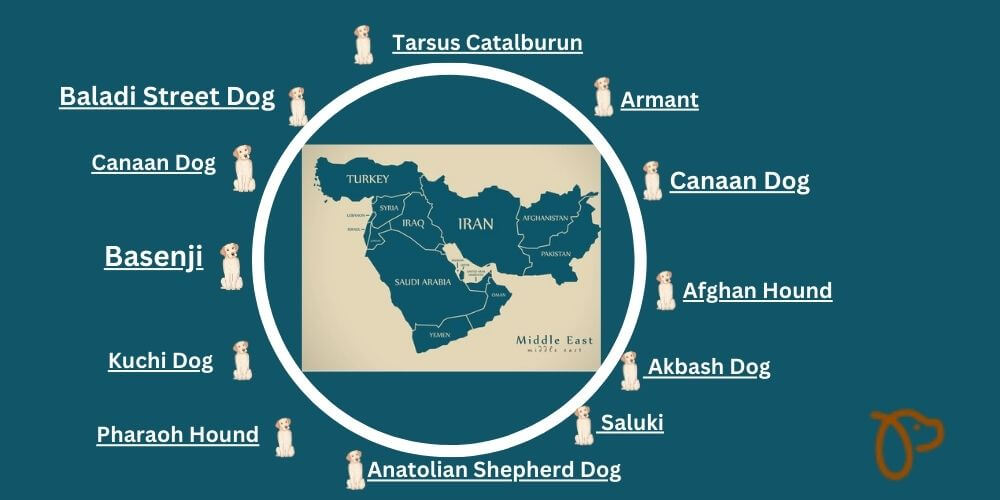The Middle East has a rich history with dogs. People there have loved and domesticated dogs for a very long time, with evidence going back 12,000 years.
In Israel, for instance, an old burial site shows a man holding his puppy, proving that the Middle East has always been fond of dogs.
Granted, it was central Asia that began domesticating dogs but the Middle East followed suit not long after.
Most Middle Easterners bred dogs for hunting and companionship, creating breeds tough enough for the desert.
Now, some of these Middle Eastern breeds have become popular worldwide.
Here is a list of the most popular dog breeds from Middle East:
1. Saluki

The athletic and elegant Saluki is the oldest dog breed known to man. The name is Arabic for ‘the noble dog’ and no doubt the Arabs loved this breed more than any other.
Back when dogs were viewed to be unclean animals, a nomadic group of the Arab nation found the breed to be a gift from Allah.
They prized the Salukis for their regal and athletic looks. They make such great hunters as they can run fast and trek long distances in the hunt.
The breed has spread across the planet and dog lovers pay huge bucks to get one single puppy.
Related Post: How Much Does a Saluki Dog Cost?
2. Afghan Hound

As the name suggest, the Afghan hound originates from Afghanistan.
The breed was originally called Tazi, a name given to them by the ancient people of the Middle Eastern country.
Just one look at the breed and you will know that he is exceptional. When he walks into the room with many other dogs, he will instantly steal the attention.
His dramatic silky coat, thin, fashioned model physique, and exotic face make him an instant showstopper.
The Afghan hound is not only popular because of his appearances. His affectionate, adaptable, and friendly character also make him a sought-after family pet.
As long as you maintain a tight grooming schedule for his long-haired coat and offer his daily dose of exercise, you will have a wonderful companion in him.
3. Canaan Dog

Also known as the Bedouin Sheepdog or the Palestinian Pariah Dog, the Canaan Dog dates back to pre-biblical days.
The breed originates from the Middle East particularly Jordan, Israel, Lebanon, Syria, Iraq, and the Sinai Peninsula.
Measuring 40-55 lb (18-25 kg), this breed is medium-sized.
He is athletic, fierce, and loyal no wonder the Bedouins used him to guard their camps and herds.
With a dense and harsh outer coat as well as a close and profuse undercoat, this breed can handle the Middle Eastern heat with no issues at all.
4. Pharaoh Hound

The Pharaoh Hound is an ancient breed with an Egyptian Heritage.
It is believed that he was around when Pharaohs ruled the land. He later made his way to the Middle East and Malta alongside Phoenician traders.
The Malta people used the breed to hunt rabbits no wonder they call it ‘kelb tal-fenek’ which means ‘rabbit dog’.
Middle Easterners and other people of the world utilize the Pharaoh hound for hunting and primarily as a pet.
5. Baladi Street Dog

While the Baladi Street Dog doesn’t necessarily have his roots in the Middle East, he is quite common in the region.
Both the streets and countryside of this part of the world are filled with them. They must have found their way to Israel and other Asian countries from Egypt.
The ears are pricked and large and the body slender and somewhat muscular. They may look less refined but these dogs make great companion dogs.
6. Basenji

The Basenji is famous for being barkless. Instead of barking like other dogs, this breed communicate through a unique method known as yodeling, thanks to his unusually shaped laryn. He may also scream on occasion.
Yodeling is a unique vocalization method where certain breeds, like the Basenji, produce a sound that resembles a mix of howling and yelping.
What many people don’t know is that this breed has roots in the Middle East.
Sure, history shows that the Basenji originates from DRC in Africa but there is enough evidence to show that his ancient home is in the Middle East.
To be more accurate, the dog came about after Middle Eastern village dogs bred with African breeds. It is safe to say that he is among breeds from Asia.
A Basenji is loyal, alert, and gentle. Sadly, he can also be very stubborn. You need tons of patience when training him. He is reserved with new people but loves making bonds with his owners.
Related Post: 15 Small Dog Breeds That Don’t Shed or Bark
7. The Akbash Dog

The Akbash Dog, originating from Turkey, derives its name “Akbash” from the Turkish phrase “Akbaş,” translating to “white head.”
This breed, also referred to as Akbash Coban kopegi or Coban kopegi, is often mistaken for the Great Pyrenees due to its striking white coat and confident demeanor.
Renowned for exceptional guardian instincts and loyalty, the Akbash is closely linked to the Kangal dog breed, both being large herding dogs from Turkey.
Traditionally utilized by the people of Anatolia as livestock guardian dogs, they exhibit remarkable loyalty and protective traits toward their families.
While generally gentle and protective within their household, they can display suspicion and a protective stance towards strangers.
Their history as dedicated protectors and their steadfast loyalty make them prized companions and guardians.
8. Anatolian Shepherd Dog

As hinted above, another notable Middle Eastern dog that is related toAkbash is the Anatolian Shepherd.
Originating from the Sivas province of Turkey, the Anatolian Shepherd is believed to have been developed from the Coban Kopegi, also known as the “shepherd’s dog.”
This ancient breed was purposefully bred as a livestock guardian, specializing in protecting sheep and goats from predators like wolves and bears.
The breed is famed for its enduring strength, courage, and steadfast dedication to its duty, which it has preserved these exceptional traits across generations.
In certain circles, it’s known as the Kangal Shepherd Dog, Kangal, or Turkish Kangal, leading many to believe that the Anatolian Shepherd and Kangal Shepherd are identical breeds.
However, they are distinct.The misconception stems from their shared origin which dates back to 2,000 BC in Turkey, as depicted in ancient carvings resembling both breeds.
The Kangal tends to be larger and heavier, reaching up to 33 inches and weighing 90 to 145 lbs, compared to the Anatolian Shepherd’s potential size of 30 inches and a weight range of 80 to 140 lbs.
The Akbash breed is also frequently mistaken for Anatolian Shepherds and Kangals. However, it distinguishes itself from the latter breeds with its lighter and more slender appearance.
9. The Tarsus Catalburun

The Tarsus Catalburun, also known as the Turkish Pointer, stands as one of the world’s rarest dog breeds, with an estimated population of fewer than 200 globally.
Originating from the Mersin region in southern Turkey, this exceptional breed showcases a distinctive and notable characteristic—a fork-like or double nose, an uncommon feature even among canines. The deepening of the nasal groove gives the impression of a split or forked nose, setting the Catalburun apart.
Notably similar to the Spanish Pachón Navarro breed, it is speculated that the Turkish Pointer’s lineage may have connections to a few Pachón Navarro dogs that migrated from Spain to Turkey during the 18th century.
Renowned for their intelligence, loyalty to their families, and innate tracking and pointing abilities, Catalburuns have historically excelled as hunting companions, particularly for partridge hunting.
Beyond their hunting prowess, they make delightful and enjoyable companions for the entire family.
10. The Armant

The Armant, also known as the Ermenti or the Egyptian Sheepdog, is indigenous to Upper Egypt, particularly along the Nile’s banks.
The breed earned its name from the town of Armant, situated near Thebes on the Nile’s west bank in Egypt’s upper region—an ancient locale rich in history.
There’s speculation that the Armant may have roots in the Briard, a French breed potentially brought to Egypt by Napoleon’s armies around two centuries ago.
Researchers suggest that the Armant might have evolved from crossbreeding the Briard with various European dogs introduced to Egypt by Napoleon’s troops.
Recognized by the Egyptian Kennel Foundation (EKF) as among the nation’s most loyal herding dogs, the Armant showcases remarkable fearlessness when confronting predators, reflecting the storied resilience of its namesake town.
Although they are aggressive towards herd-threatening predators, they exhibit a gentle and affectionate demeanor towards their family. This makes them exceptional family companions and beloved pets for children.
However, exclusion from family life can induce stress in Armants, leading to destructive behavior. Therefore, they thrive best when considered integral family members.
11. The Kuchi Dog

The Kuchi Dog, also known as the Afghan Shepherd Dog, originates from native regions in Afghanistan and Pakistan.
Sharing genetic similarities with the Central Asian Ovcharka, it’s often regarded as a variant of the CAO breed.
Named after the Afghan Kochi people, credited as the first discoverers of these molosser-type dogs, the Kuchi was developed by Afghan nomads specifically as a working breed. Their primary role involved guarding caravans and livestock against potential threats from predators and thieves.
Adaptability characterizes this breed, enabling them to swiftly acclimate to various climates across the Middle East.
Despite their adaptability, Kuchis exhibit extreme suspicion towards strangers, displaying a reluctance to readily accept unfamiliar individuals. Establishing trust with them requires considerable time, as they are not predisposed to welcoming newcomers.
Although more prevalent in Pakistan and Afghanistan, the Kuchi Dog remains a rare breed outside these regions.
Final Thoughts
Surprisingly, the Middle East isn’t just known for its vast oil reserves or hosting some of the world’s largest spice markets.
People in this region have also cherished dogs for centuries.
This list confirms that fact.
For those seeking a Middle Eastern dog breed, there are several options available.
Related Post: 10 Best Southern Dog Breeds
As an Amazon Associate, we may receive a small commission from qualifying purchases but at no extra cost to you. Learn more. Amazon and the Amazon logo are trademarks of Amazon.com, Inc, or its affiliates.

